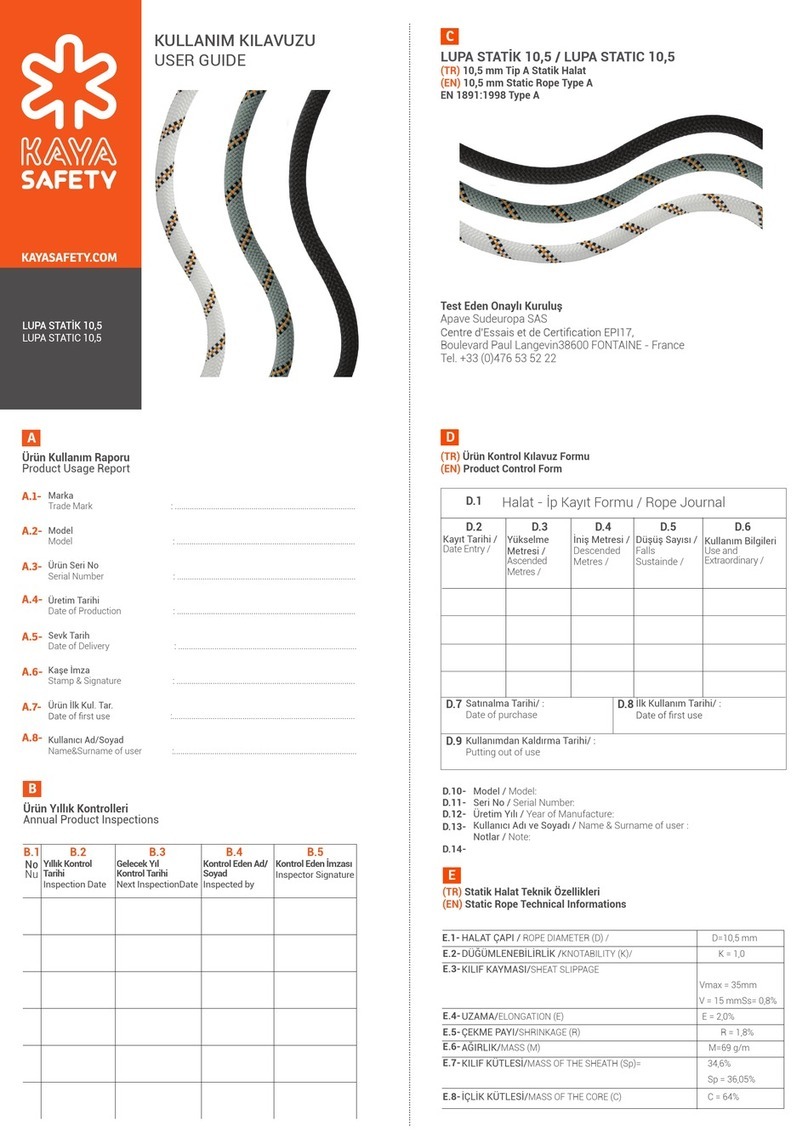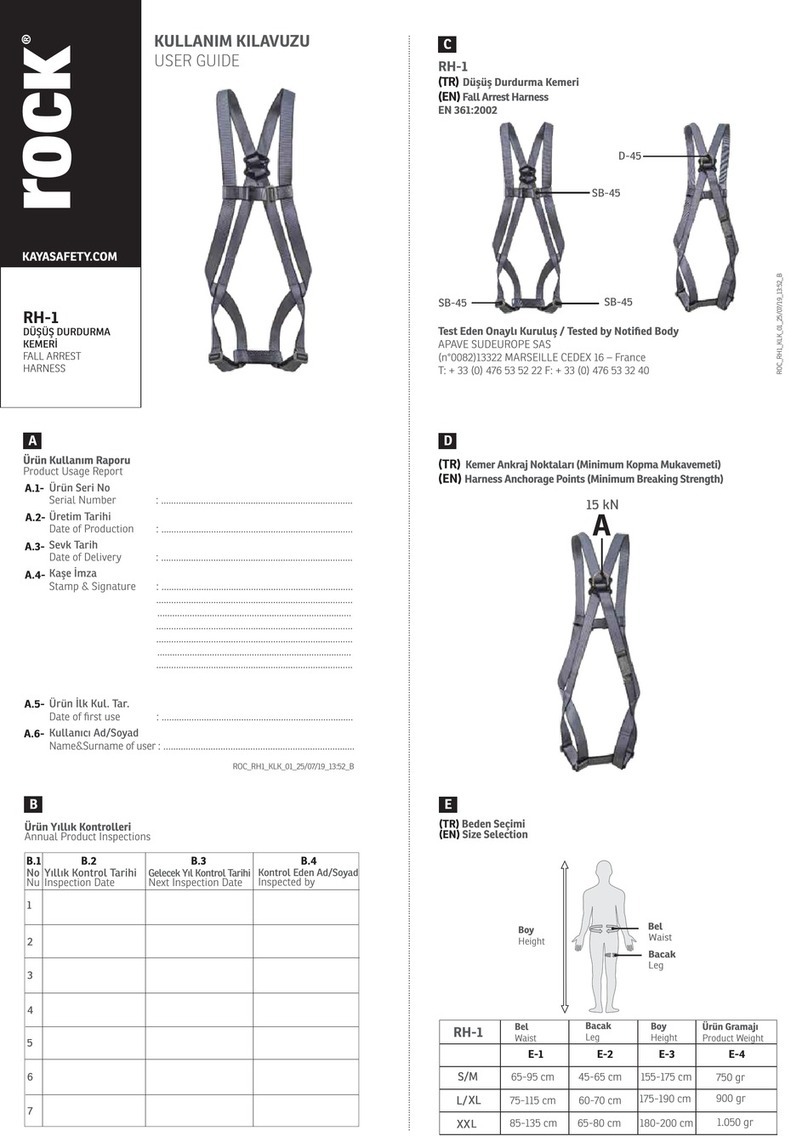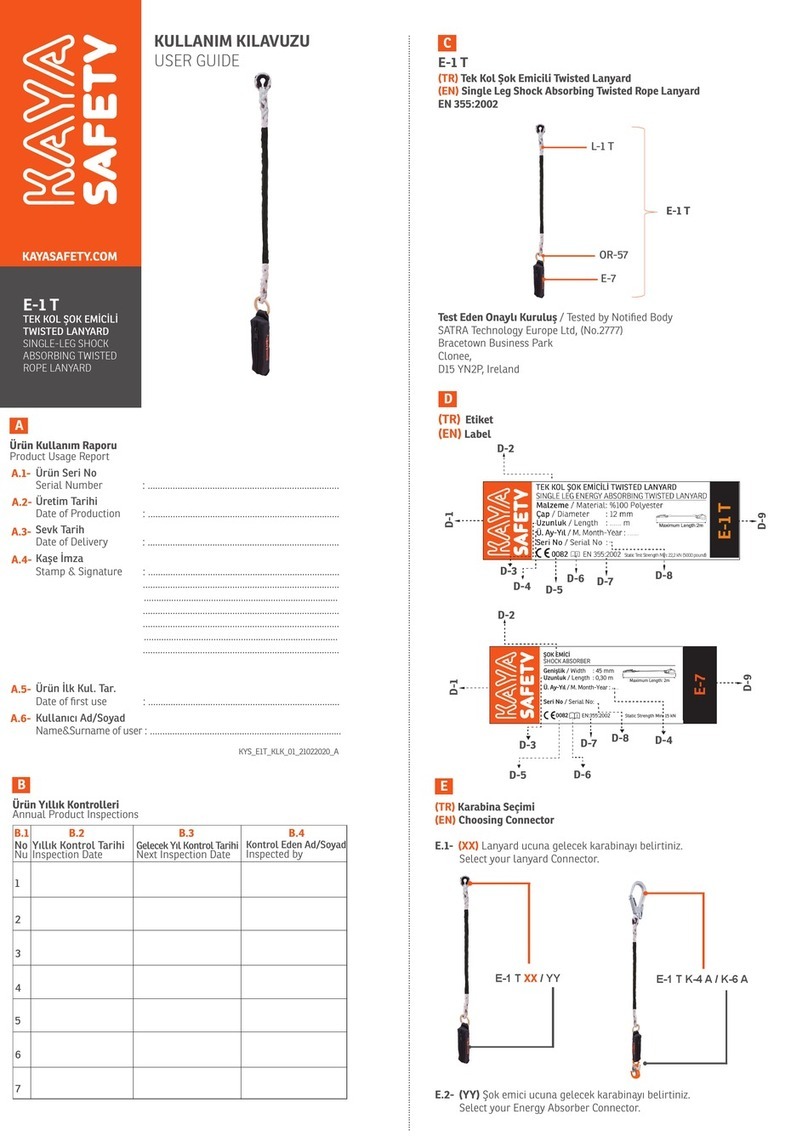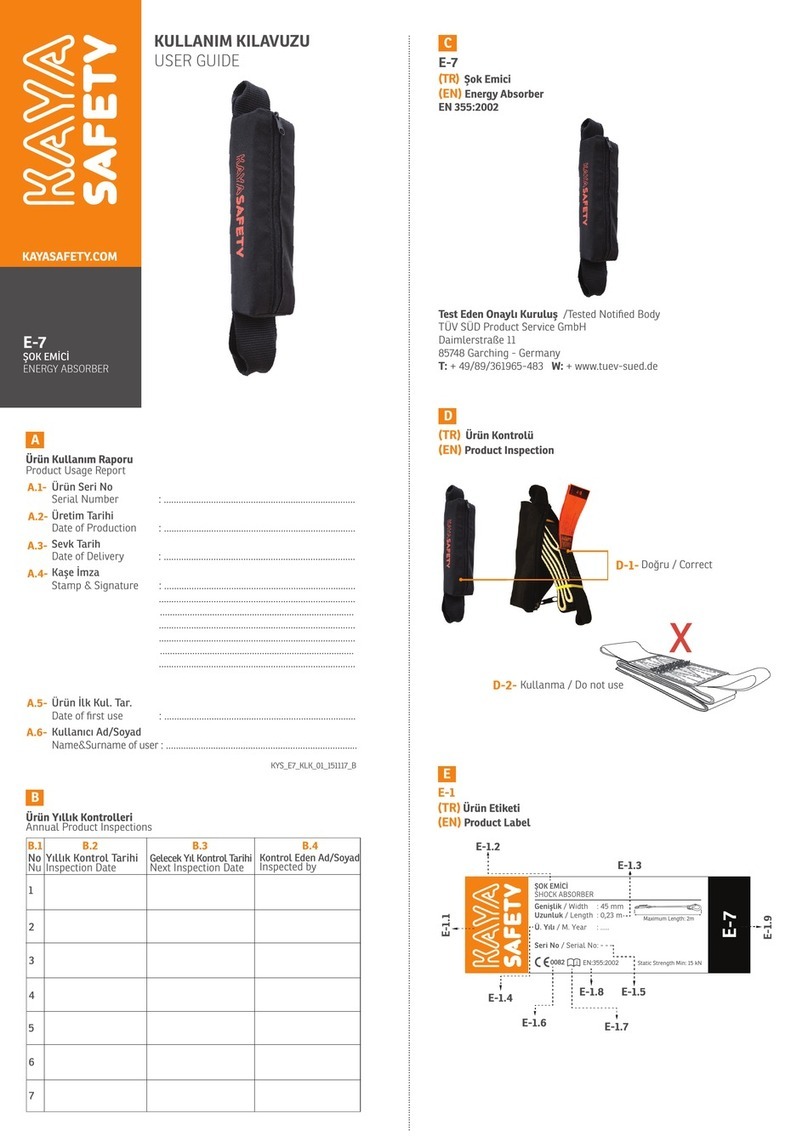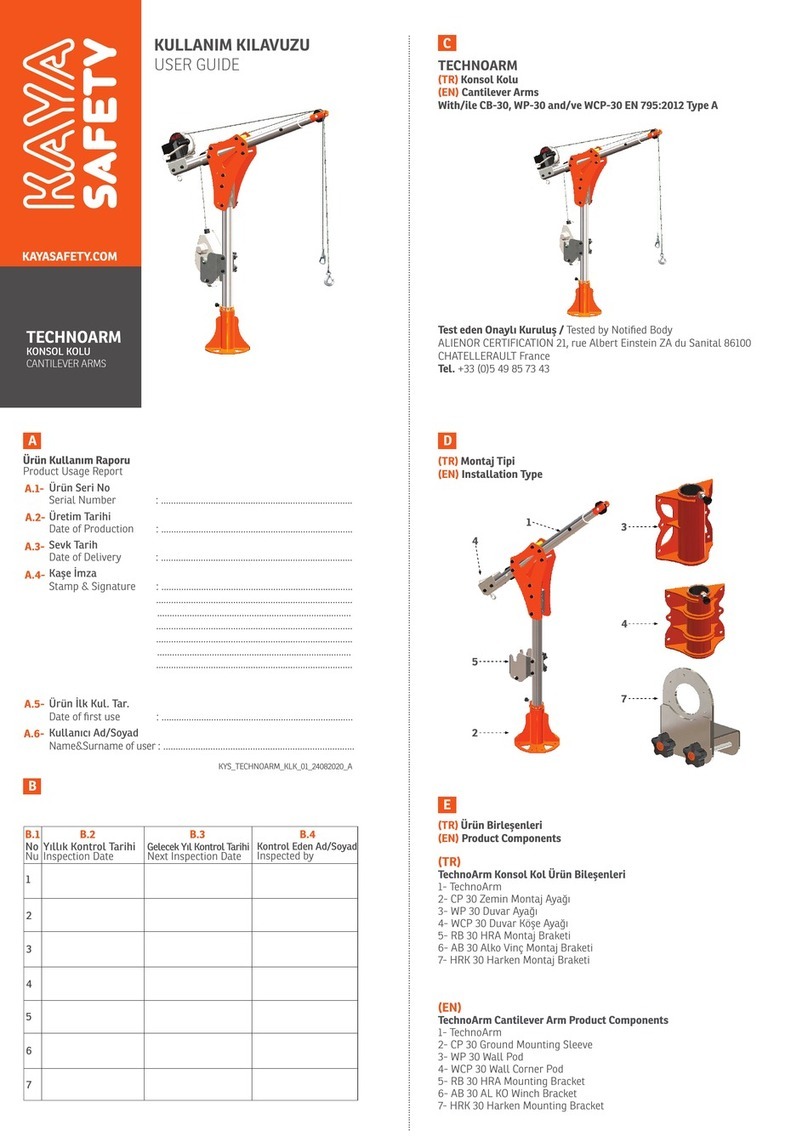
.........................................................................................................................................................................................................................................................................................................................................................................................................................................................
J.1.3- After that pull the webbing to adjust.
Using Harness Buckles (Figure - J-2)
J.2.1- Harness Buckles SB-45
J.2.2- Pass the webbing through the buckle.
J.2.3- Pass the webbing through the buckle again.
J.2.4- After that pull the webbing to adjust.
1. Caution
1.1- Working at height is one of dangerous activities that can lead to serious
injuries and death. It is under the responsibility of the user to learn
appropriate usage techniques and safety methods, and apply these
in practice. This full body harnesss should be used by only a trained
personnel or under the supervision of such personnel. Improper use can
cause serious injuries and fatal accidents.
1.2- There must be a plan of rescue that is to be applied in case of
emergency which may occur during working at height.
1.3- This safety harness is a component of a fall arrest system and is aimed
to prevent user from falling. This equipment itself is not suitable for working
at height, it must also be used together with CE certificated lanyards (EN
354), shock absorbers (EN 355), hooks (EN 360) and fall arresters.
2. Raw Material
This safety harness is made of;
* Textile Materials: % 100 Polyester
* Metal Parts: Aluminium and Steel.
* Accessories: Polyester, Polyamide and PVC
3- General Specifications
Personal Protective Equipment (PPE)
This full body harness enables the user to work safely by making a
connection to a secure point with an appropriate equipment. This safety
harness is manufactured in comply with standards of EN 358 and EN 361
specified in the directive 89/686/EEC and TÜV SÜD Product Service No.
CE0123
4. Product Use
4.1- EN 361:2002 Fall Arrest Harness
* Full Body Fall Arrest Harness
stnenopmoclla,retserrallafsadesusissenrahtserrallafydobllufnehW
of the system should comply with the requirements of EN 363 (full fall
arrest systems). Remaining equipment which are anchoring points of
harness must comply with EN 795, Lanyards must comply with EN 354,
Shock absorbers must comply with EN 355, Carabiners must comply with
EN 362.
* Back and Chest D Ring; ( Figure- 1 )
Use only back and front D rings of safety harness with other equipment
described in EN 363 ( Shock absorber, lanyard, fall arrest systems). These
points were marked with “A” in order to be recognized easily.)
4.2- EN 358:1999 Work Positioning Harness
Always use side D rings located on the back pad with a lanyard as shown in
Figure - 2 Always make sure to place the lanyard at the same level of your
waist or above when positioning is performed.
4.3- Fall Clearance = A+B+C+D
Figure - 3 ; Fall Clearance ( Calculation of fall clearance distance)
Clearance distance should be calculated in the working area for a possible
fall. In case of fall from height, user should be able to adjust the clearence
distance in order not to hit any object or ground.
Fall Clearance
Fall clearance is the height at which a user must attach to an anchorage to
avoid contact with a lower level. In order to calculate required fall clearance
distance the following measurements must be kept in mind.
A : Length of Fall Arrest System (Lanyard)
B : Length of the Lanyard after a fall
C : Height of Suspended user
D : Safety Factor
5. Product Inspection and Validation
5.1 Before Each Use
Working at height equipment must be used as personalized.
These products must be controled on a regular basis before and after
each use and findings must be recorded into product control form. On
an adequate lighted environment apply following controls by lying the
product down on a flat surface;
* Webbings should be checked for cuts, abrasions, color change, broken
stitches and undue stretching.
* Buckles should be checked for signs of wear, cracks, deformation,
corrosionor other damages. They should function correctly and smoothly.
* D Rings and other metal parts should be checked for signs of wear, cracks,
deformation, corrosion or other damage.
* Connectors should be checked for sign of wear, cracks, deformation,
corrosion, dirt. The gate and the locking mechanisms should work easily
and without any problem. The gate should open and close completely.
* Labels should be secure and legible.
During the controls if at least one of these deviation is found, usage of
the equipment should be suspended or retired and immediately send back
to producer for detailed inspection. No repair is allowed by unauthorised
person. Only manufacturer directions should be applied.
5.2 During Each Use
When use product with a system , make sure that all pieces of equipment in
the system are correctly positioned and compatible with each other.
6. Supplementary Information Regarding Standard; EN 365
6.1 Rescue Plan
A user who has been incapacitated by an injury or medical condition and
who is suspended by the full body harness must be rescued immediately. So
you must always have a rescue plan for such emergency situations. Thus,
adequately trained personnel and rescue equipment must be present.
6.2 Anchor Point
The anchor point of the system comprises this product should preferably
belocated above the user or should at least at the waist level of the user.
An attachment point below this level will cause a serious injury or death.
The anchor point must conform to the requirements of the EN 795
standard and the minimum strength of 12 kN.
6.3 Various Situations
* A fall arrest harness is the only device allowed for supporting the body in
a fall arrest system.
* In a fall arrest system, it is essential to check the required clearance
under the user before each use, to avoid any collision with the ground or an
obstacle in case of a fall.
* Make sure that the anchor point is correctly positioned, in order to limit
the
risk and the height of a fall.
* When using multiple pieces of equipment together, a dangerous situation
may occur if the safety function of one piece of equipment is affected by the
safety function of another piece of equipment.
* Users must be medically fit for activities at height. Warning, inert
suspensionin a harness can result in serious injury or death.
7.Kaya General Information
7.1 Life Span
This product’s maximum lifespan is 10 years. (10 years is the time of storage
without being used, the product should be destroyed even if it has never
been used during this time)
If the product has one of the deviations below it should be withdrawn from
service immediately and should be destroyed to prevent further usage.
* It has suffered a heavy shock load or a load dropped onto it.
* There are discoloration, stiffness, cuts and tears, glazed or fused areas
on the webbing.
* There are cracks, deformation, corrosion or excessive wear on the metal
parts.
* It fails to pass inspection (before usage or detailed inspection)
* Labels (markings) are illegible or absent
* It is extremely dirty and does not respond to normal washing.
* It has come into contact with chemicals and especially acids or is even
suspected.
* Its history is unknown.
* Its lifespan stated in the user’s manual has expired or even it has never
been used.
* There is a slightest doubt that the product is no more safe and reliable.
7.2 Storage
Product is sold with storage bag and user guide. Additionally model and
applied standards are provided with the product. During the storage
keep the product in its own bag. Storage area of the product should meet
following requirements;
* Dry, away from direct sun light, room temperature
* Do not store together with acids, solvents etc.
* Keep away from direct heat sources.
* If the product gets humidity during the storage, dry the product in room
temperature before usage.



